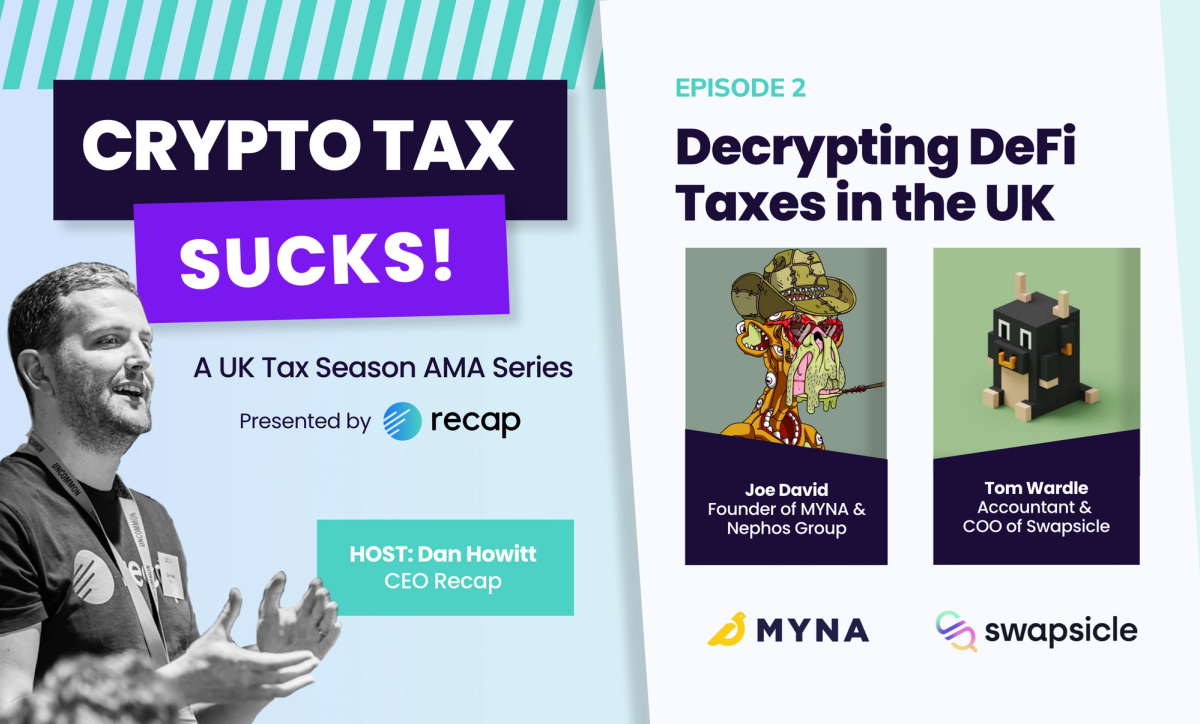

DeFi, short for Decentralised Finance, is an innovative concept in the world of cryptocurrency that leverages blockchain technology to enable users to participate in various financial activities, such as lending, borrowing, trading, and more, without relying on traditional intermediaries like banks.
This guide aims to simplify the complex world of DeFi taxation for crypto enthusiasts and investors. We will cover essential topics to provide a basic understanding of DeFi and HMRC’s latest DeFi tax guidance before delving into the intricacies of DeFi taxation for specific activities including staking, liquidity pools, wrapped tokens, and lending. It's important to note that although we refer to this as "DeFi" guidance some of this activity can be practiced on centralised exchanges with the same tax application.
By the end of this guide, you’ll have a clearer grasp of the tax implications associated with your DeFi transactions.
HMRC Decentralised Finance: Lending and Staking 2022
In 2022 HMRC published an additional section “Decentralised Finance: Lending and Staking” within their Cryptoasset Manual. This guidance sparked considerable criticism within the crypto industry, prompting a subsequent call for evidence and consultation. Whilst HMRC’s DeFi guidance is subject to potential evolution, the process of drafting and implementing new legislation is time-consuming and consequently, it might take years to take effect. This guide provides the latest insights and will be updated as necessary to ensure ongoing relevance.
Disclaimer
This guide is intended as a generic informative piece. This is not accounting or tax advice that can be relied upon for any UK individual’s specific circumstances. Please speak to a qualified tax advisor about your specific circumstances before acting upon any of the information in this article.
What is DeFi?
DeFi, or Decentralised Finance, is a blockchain-based financial ecosystem that operates without traditional intermediaries, offering decentralised, permissionless, and transparent financial services to users globally.
The heart of DeFi lies in smart contracts, which automate transactions. Users can engage in a range of activities including trading, borrowing, lending and liquidity pools. Unlike in centralised systems where financial institutions would have control over these transactions, incurring time delays and extra costs, in DeFi anyone can participate without approval. This approach empowers users across the globe to access transparent and publicly verifiable financial services without geographical restrictions.
DeFi makes finance more inclusive, efficient, and open to all, with decentralised applications (dApps) running on blockchains like Ethereum, Solana, and Avalanche.
How is DeFi taxed?
Decentralised finance may be permissionless but it is taxable, and unfortunately understanding how can get pretty confusing as it often depends on the mechanics and the terms and conditions of the specific DeFi protocol and the type of activity you are participating in.
Rewards from DeFi activity may be subject to capital gains or income tax depending on whether a transaction is capital or revenue in nature. Additionally, when engaging in activities like lending, staking and liquidity pools, you need to consider the capital gains tax position of the principal tokens when entering and exiting, as well as the tax treatment for rewards generated.
Income tax for DeFi transactions
When you earn rewards for engaging in DeFi activity, for example from staking and lending, these rewards will likely be subject to income tax, reported on the tax return as miscellaneous income and taxed at your regular income tax rate. In rare circumstances, tax payers may be classed a ‘financial trader’ in cryptoassets and rewards are then reported as trading income.
Tax on airdrops
DeFi airdrops are considered as taxable income if they are received in return (or expectation) of performing a service. Regardless of whether the airdrop was treated as taxable or non-taxable upon receipt, the crypto asset will be subject to capital gains tax when disposed of. Take a look at our article about airdrops to find out more.
Capital gains tax for DeFi transactions
Normal capital gains rules apply when you trade and sell crypto on decentralised exchanges. Just like on a centralised exchange, each time you dispose of a cryptoasset (by selling it for fiat, exchanging crypto to crypto, purchasing with crypto, or gifting crypto), you trigger a capital gain or loss depending on how the price of your crypto has changed since you originally acquired it (but watch out for the non-intuitive matching rules). When your net capital gains for the year exceeds the annual capital gains allowance you will pay capital gains tax at a tax rate dependent on your total annual income.
In addition to to calculating the tax position upon the ultimate disposal of the tokens, the following DeFi transactions might also be subject to capital gains tax if a change of beneficial ownership takes place at the time of entry/exit:
- Adding/removing your crypto to/from a liquidity pool
- Lending out your cryptoassets
- Depositing crypto assets as collateral for a loan you take out
- Staking your cryptoassets
To learn more about how cryptocurrency is taxed, and find more detail on tax allowances and tax rates then take a look at our detailed UK Crypto Tax Guide.
HMRC’s new guidance on DeFi lending and staking
In February 2022, HMRC published new guidance in their Cryptoasset Manual titled ‘Decentralised Finance: Lending and Staking’ indicating that investors need to consider the tax treatment of lending and staking activities as set out below:
- Return/reward generated from the yield generating activity:
- taxed as income or capital gains?
- taxed at the time of entering activity, when received, or both?
- Principal tokens locked away when staked/loaned/added as collateral:
- capital gains tax disposal upon entry of the yield generating activity?
- capital gains tax disposal upon exit from the yield generating activity?
Understanding how my DeFi transactions are taxed based on HMRC guidance?
You can follow the steps below to help establish how your DeFi transactions should be treated for tax. This can become very complex and seeking help from a tax professional or legal advisor is recommended.
1. Is the reward income or capital?
The tax treatment of income or capital for the reward received by the lender/liquidity provider depends on the structure of the transaction. HMRC have set out some guiding principles for determining the nature of receipt as capital or revenue and we summarise some indicators below:
| Capital | Income | |
|---|---|---|
| Return earned by providing a service to the borrower/DeFi lending platform | ✅ | |
| The return is | realised from the capital growth in value of an asset owned by the lender/liquidity provider | paid to the lender/liquidity provider by the borrower/DeFi lending platform |
| At the time of agreement, the return is… | unknown/ speculative | known / agreed |
| Return is paid… | upon repayment of the principal a one-off payment | periodically throughout the period of lending |
| The period of lending | indefinite or long term | fixed or short term |
2. Is beneficial ownership transferred?
You will need to examine the terms and conditions for each type of lending/staking activity to understand if beneficial ownership has been transferred.
- Where the recipient is able to deal with the tokens as they wish, it is a strong indicator that they have acquired beneficial ownership.
- Where the recipient is restricted from dealing with the received tokens, it is a strong indicator that the lender/liquidity provider has retained beneficial ownership.
3. Consider the tax treatment
Using your decisions on income vs capital and whether beneficial ownership transferred, you can work out the tax treatment for the principal token on entry and exit from the yield generating activity. This becomes complex as there are so many different scenarios with different tax outcomes, take a look at our technical tax guide for full detail.
Now that we have introduced the different concepts of capital and income rewards and explained the importance of the transfer of beneficial ownership, we will explore the taxation of different types of DeFi transactions in more detail.
What is liquidity mining tax?
A liquidity pool is a crowdsourced pool of cryptocurrencies or tokens locked in a smart contract that is used to facilitate trades between the assets on a decentralised exchange (DEX), providing liquidity and convenience to the DeFi ecosystem. When a user supplies a pool with liquidity, they are often rewarded with Liquidity Provider (LP) tokens in proportion to the amount of liquidity. When the pool facilitates a trade, a fractional fee is distributed proportionally amongst the LP token holders. DeFi protocols like Uniswap and Curve offer liquidity pools built on various blockchain platforms like Ethereum and Polygon.
According to HMRCs guidance, when engaging in liquidity pools you may have a tax liability on entering and exiting the pool as well as on rewards received. This however is only the case where you lost beneficial ownership of your tokens whilst they were in the pool.
Tax on liquidity pool rewards
Tax on liquidity pool rewards depends on if the nature of the liquidity pool reward is capital or income.
Income in nature: the liquidity pool reward is taxable as miscellaneous income based on the sterling value of the received reward on the date it was receivable. (Or, for “financial traders” treated as trading income).
Capital in nature: the reward is subject to capital gains tax - please refer to our technical guide for more detail on when this is taxed.
It’s important to record the acquisition cost of the liquidity pool reward when received, as this assists with the CGT calculation when these tokens are later disposed of.
Tax on entering and exiting a liquidity pool
No change in beneficial ownership: If there is no transfer of beneficial ownership then a capital gain is not realised when tokens are added or removed from the pool.
Change in beneficial ownership: If there is a transfer in beneficial ownership, this triggers a capital gain or loss at the time of adding and removing your cryptoassets to/from a liquidity pool:
- When you enter a liquidity pool, you lock away the principal token and receive a redemption token. This is viewed as:
- a CGT disposal of the principal token - the disposal proceed are the sterling market value and there could be a gain or loss
- an acquisition of the redemption token - the acquisition cost is the sterling market value of the disposed token
- When you exit the pool, you reacquire the principal token and dispose of the redemption token. This is viewed as:
- an acquisition of the principal token - the acquisition cost is the sterling market value of the token re-acquired
- a disposal of the the redemption token, where proceeds are the market value of the reacquired principal token
Although the principle is the same, tax is applied differently depending on if the liquidity pool rewards are deemed income or capital in nature, please seek help from a tax professional or refer to our technical guide for more detailed information.
DeFi taxes on lending
Some DeFi protocols such as Aave and Compound allow crypto users to secure loans by depositing their crypto as collateral. Interest rates are determined by the market and shift in response to supply and demand. When lending crypto on decentralised platforms you may be subject to income tax and/or capital gains tax, depending on the nature of the reward and if there is a change in beneficial ownership.
Tax on your lending rewards
Income in nature: If you decide the nature of your lending rewards is income, your tokens will be taxable as miscellaneous income, subject to income tax at their sterling value at the date they are receivable.
Capital in nature: If you decide your lending rewards are capital in nature, then at the point of loaning out your tokens, a capital gain is realised on the reward (based on the estimated present value of the future reward). This gain upon entry is then re-assessed upon receipt of the capital reward (usually upon repayment to you of the tokens lent out), based on the value of the reward when received.
Tax when loaning out and receiving repayment of your tokens
There is no income tax on the principal tokens, but you need to consider the capital gains tax positions at the time of loaning out and at the time of receiving the repayment of your cryptoassets.
The capital gains tax treatments differs depending on whether beneficial ownership changes when the tokens are loaned out - take a look at our <technical guide> for more detail and get help from a tax professional where required.
DeFi taxes on borrowing
The tax position for an individual borrowing tokens is simpler to understand as the same treatment applies regardless of any change in beneficial ownership!
Receipt of loan: When the loan is received there is an acquisition of the tokens borrowed, at their sterling market value at date of receipt.
Don’t forget that depending how the loan is used, there may be further taxable events. For example, if the loan is used to purchase other cryptoassets then these would be disposals and normal capital gains tax would apply.
Repayment of Loan: When the loan is repaid this is classed as a disposal subject to capital gains tax based on the sterling market value at the date of repayment.
There is no tax relief for any lending fees paid to the lender however if the fee is paid using cryptoassets this is subject to CGT.
How is staking taxed?
Crypto staking involves locking up a certain amount of cryptocurrency in a blockchain network to support its operations, earning stakers rewards in the form of additional cryptocurrency. For instance, staking Ethereum in a proof-of-stake network to validate transactions and receive additional Ethereum as a reward.
When staking crypto, you may be subject to income tax and/or capital gains tax, depending on the nature of the reward and if there is a change in beneficial ownership.
Tax on the staking reward
Income in nature: The sterling value of the crypto staking reward is taxable as miscellaneous income (or in rare circumstances, where the staking activity amounts to financial trading - trading income).
Capital in nature: A capital gain is realised at the time of staking the crypto tokens (based on the estimated present value of the future capital reward). This is then re-assessed upon receipt of the capital reward, based on the value of the reward when received.
Tax at the time of staking and receiving staking reward
If there is a transfer in beneficial ownership at the time of staking then you need to consider the capital gains tax position of the tokens. For detailed information take a look at our Technical Tax guide for the UK or get assistance from a tax professional.
Key Takeaways DeFi Tax
- Income tax and capital gains tax can apply to DeFi activity depending on the type of activity and the nature of the transaction. You also need to consider if there is a change of beneficial ownership when lending, staking and participating in liquidity pools.
- Popular ways of earning through decentralised finance are staking, yield farming and liquidity mining
- HMRC guidance around DeFi is quite vague and is currently being reviewed, however this does not mean DeFi activity is tax free. It is vital to comply with present tax regulations and track all of your crypto transactions regardless of possible changes to the tax rules and what crypto data you believe HMRC can access.
- DeFi tax calculations and reporting are complex therefore tools like Recap and professional help are essential to ensure you submit an accurate tax report.
To stay on top of your crypto taxes and track your cryptoassets all in one place, start your journey with Recap and sign up for free today.



